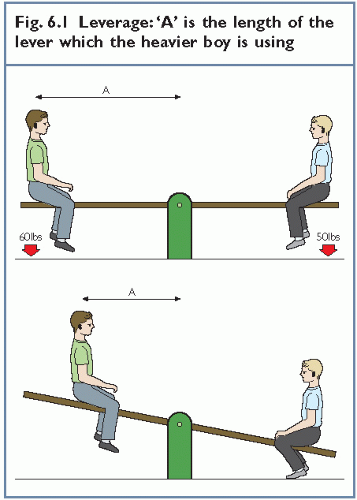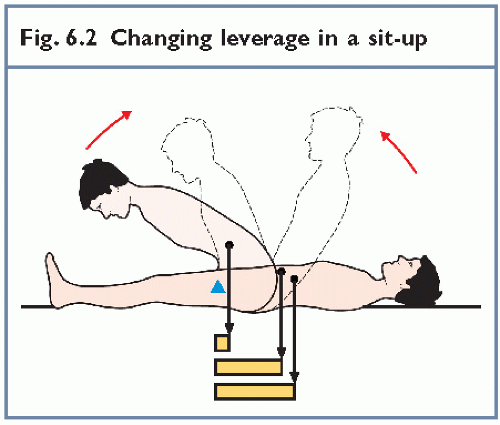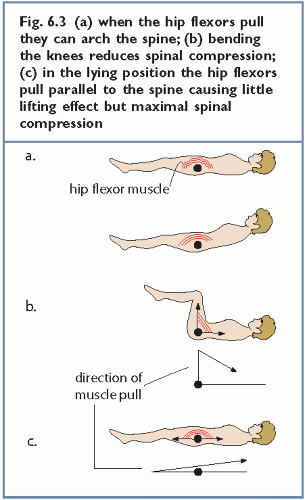Common Abdominal Exercises
One of the aims of this book is to improve the standard of abdominal exercises by making exercises for this body part both safer and more effective. To fulfill this aim, the first thing we need to do is to take a close look at some commonly practised exercises and see where these go wrong. Although these exercises have been practised for many years in numerous gyms and exercise classes, there is still much room for improvement.
The sit-up
The sit-up is often the first exercise approached when abdominal training is considered. Unfortunately this exercise has a number of inherent dangers, especially for the spine. By knowing what happens to the body during this action we can reduce these dangers considerably.
Begin the exercise lying flat on your back. As soon as you lift your head from the floor, the abdominal muscles begin to work. This is because the muscles lifting the neck pull on the ribcage. To stop the ribs from moving, and hold them firm, the abdominal muscles must tighten. As the exercise continues, you begin to lift your trunk from the floor. To do this, your legs have to stay down. However, because your legs are lighter than your trunk, the tendency is for the legs to lift, unless the trunk is bent. Bending the trunk reduces the effect of leverage, and makes the trunk ‘lighter’.
As an example of this mechanism, study fig. 6.1. Two boys are sitting on a seesaw. The one on the right weighs 22 kg (50 lb), but the boy on the left is heavier and weighs 27 kg (60 lb). The seesaw is balanced at the moment, but if the lighter boy wants to lift the heavier boy, the heavier boy must move closer to the pivot point. This reduces his leverage effect and can be thought of as making him ‘lighter’.
The same principle applies with the sit-up. If the trunk is to lift instead of the legs, the leverage effect of the trunk must be reduced. To do this the trunk must bend so that its weight moves closer to the hip which is acting as the pivot (see fig. 6.2). If you are able to bend your trunk sufficiently, you will be able to sit up. But, if your abdominal muscles are weak or lengthened, your trunk will not bend enough to reduce its leverage; your trunk will stay on the ground and your legs will lift instead.
The abdominal muscles work to bend the trunk, but the lifting action which pulls the trunk away from the floor is actually carried out by the hip flexor muscles. The two major hip flexor muscles are the iliopsoas which attaches to the pelvis and lumbar spine and the rectus femoris which attaches to the pelvis.
Keypoint
The two major hip flexor muscles are the iliopsoas and rectus femoris.
These will pull hard on the spine to try to lift it up. If the legs are straight, the hip flexor muscles lie almost parallel to the spine (see fig. 6.3c). The muscles find it very difficult to lift the spine from this position, and instead they pull the lower spine into an arched position (see fig. 6.3a).
Bending the knees
If the knees and hips are bent (see fig. 6.3b), the hip flexor muscles are lifted up and they can now move the spine more easily and, as a result, will compress it less. Bending the hip therefore considerably reduces the stress placed on the lumbar spine.
Keypoint
Bending the legs in a sit-up reduces the unwanted forces on the lower back.
Bending the knees protects the spine from muscle compression, but it does have a downside. With the knees bent, the hip flexor muscles can work harder and are in a shortened position. In people who have a hollow back (lordotic) posture these muscles tend to be too tight and too short. To tighten and shorten the muscles further will degrade their posture and could increase the risk of developing back pain.
It must be emphasised that the stress on the spine from hip flexor action only occurs because the trunk is lifted clear of the ground. The action of lifting the trunk rather than simply curling it does not increase the work of the abdominals substantially, and is really unnecessary in pure abdominal training. If the trunk stays on the ground, with the abdominals being used to bend the trunk only, the effects on the lumbar spine are reduced once again and the exercise becomes quite safe.
Stay updated, free articles. Join our Telegram channel

Full access? Get Clinical Tree











